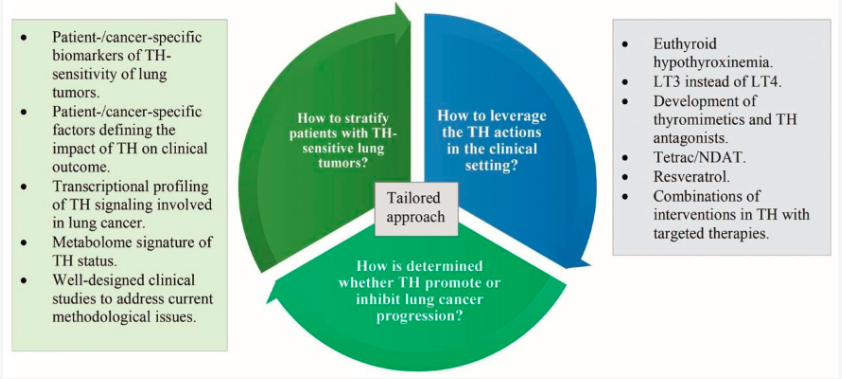
Comment:
This is a fascinating review of a complex topic. The key clinical pearl here is the paradoxical finding that treatment-induced hypothyroidism (from TKIs/ICPis) often correlates with a favorable prognosis. It underscores the need to closely monitor thyroid function in these patients—not just as a side effect to be managed, but as a potential prognostic marker and raises the question as to whether low thyroid function in people on these medications should be corrected. The link between Non-Thyroidal Illness Syndrome (NTIS) and poor survival is also a critical, and likely under-appreciated, finding.
There is also several studies showing an association between levothyroxine and cancer incidence which also needs to be considered.
Summary:
Clinical Bottom Line
This is a narrative review, not a systematic review, summarizing three decades of research on the link between thyroid function and lung cancer. It concludes that thyroid hormones (TH) have a complex, dual (both promoting and inhibiting) relationship with lung cancer. The key clinical takeaway is that hypothyroidism is generally associated with a favorable prognosis in lung cancer patients, while hyperthyroidism (even subclinical) is linked to an increased risk of developing lung cancer. The review also highlights that modern treatments like checkpoint inhibitors (ICPi) and tyrosine kinase inhibitors (TKI) frequently cause thyroid dysfunction, which clinicians must monitor.
Results
Summary of Results
This review synthesizes nonclinical, clinical, and molecular data on the thyroid-lung cancer relationship.
-
Molecular Actions: The authors detail four types of TH actions, including classic genomic actions via nuclear thyroid hormone receptors (TRs) and non-genomic actions mediated by receptors on the cell membrane, such as integrin αvβ3.
-
Role in Cancer Hallmarks: THs are shown to contribute to all “hallmarks of cancer,” including proliferation, angiogenesis, and immune evasion. The effect can be dual; for example, T4 binding to ntegrin αvβ3 is generally pro-proliferative and pro-angiogenic, while T3 can have both promoting and inhibitory effects.
-
Nonclinical (Lab/Animal) Data: Animal and cell-line studies show conflicting results. In one murine model, T3 injections inhibited metastases, while T4 enhanced tumor growth. Other models confirm that T4 promotes lung cancer growth, an effect that can be blocked by the TH-antagonist tetrac.
-
Clinical Data:
-
Prognosis: A hallmark 1993 case report described the spontaneous remission of metastatic NSCLC in a patient who had recovered from myxedema coma (severe hypothyroidism). A subsequent retrospective study found that primary hypothyroidism was a significant prognostic factor for favorable survival in lung cancer patients.
-
Risk: Conversely, prospective studies link hyperthyroidism (TSH < 0.50 mU/L) and high-normal fT4 levels with a significantly increased risk of developing lung cancer.
-
Non-Thyroidal Illness Syndrome (NTIS): NTIS (characterized by low T3, with normal or low TSH and T4) is strongly associated with lung cancer, occurring in 35-42% of patients in some studies. The review highlights that NTIS is an independent risk factor for decreased survival.
-
Treatment-Related Dysfunction: The review notes that both ICPi and TKI therapies are common causes of thyroid disorders (both hypo- and hyperthyroidism). This treatment-induced dysfunction may be associated with a favorable prognosis and better response to the cancer therapy.
-
Assertive Critical Appraisal
-
Certainty of Evidence (GRADE Framework): As this is a narrative review, the authors do not use the GRADE framework or any other formal system to assess the certainty of the evidence for its conclusions. The findings are a synthesis of various study types, from low-evidence case reports to higher-evidence population-based cohorts, and should be viewed as an expert summary rather than a high-certainty conclusion.
-
Heterogeneity (I2): This review does not perform a meta-analysis, so statistical heterogeneity (I2) is not calculated. The authors do, however, qualitatively describe the significant heterogeneity in findings between different nonclinical and clinical studies.
-
Publication Bias: The authors do not perform a systematic search or assess for publication bias (e.g., via a funnel plot).
-
Risk of Bias in Included Studies: The authors summarize the findings of various studies but do not formally appraise the risk of bias within each included study.
-
Reporting Quality Assessment (PRISMA): This article is a narrative review and does not follow the PRISMA reporting guidelines for a systematic review. It does not include a PRISMA flow diagram, a PICO-based research question, or a reproducible search strategy. This is a key methodological limitation, as it means the selection of studies included in the review is at the authors’ discretion and may not be comprehensive or unbiased.
Research Objective
The stated objective is to provide background knowledge on TH actions in cancer, give a comprehensive overview of the TH-lung cancer association over the last three decades, and identify obstacles and pending queries to clinical application.
Study Design
This is a narrative review of the literature.
Setting and Participants
The review summarizes data from a wide range of publications over 30 years. These include nonclinical (cell/animal) models and clinical studies (case reports, retrospective, and prospective cohorts) involving lung cancer patients and individuals at risk for lung cancer.
Bibliographic Data
-
Title: The Intriguing Thyroid Hormones-Lung Cancer Association as Exemplification of the Thyroid Hormones-Cancer Association: Three Decades of Evolving Research
-
Authors: Maria V. Deligiorgi and Dimitrios T. Trafalis
-
Journal: International Journal of Molecular Sciences
-
Year: 2022 (Published 31 December 2021)
This AI-generated analysis is for informational and research purposes only and is not a substitute for professional medical advice, diagnosis, or treatment. Always seek the advice of a qualified health provider with any questio1ns you may have regarding a medical condition.
Original Article:
© 2021 by the authors. Licensee MDPI, Basel, Switzerland. This article is an open access article distributed under the terms and conditions of the Creative Commons Attribution (CC BY) license (https://creativecommons.org/licenses/by/4.0/).
